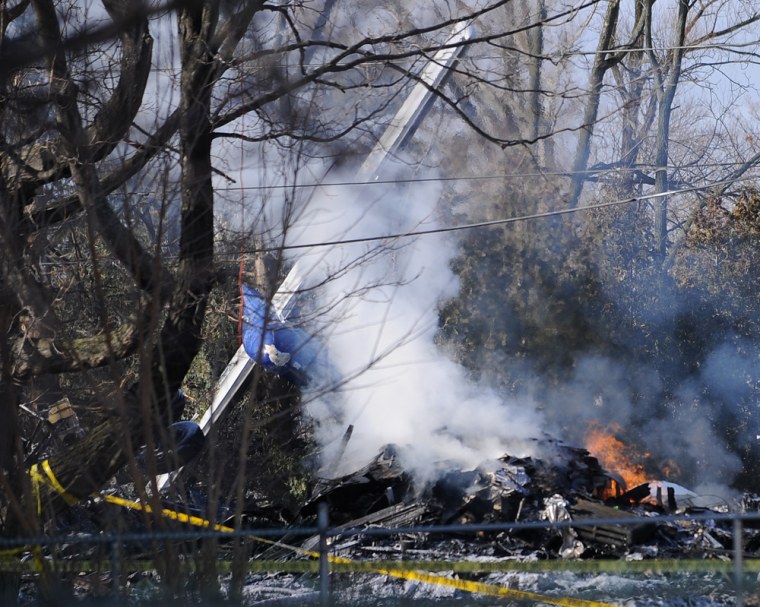Pilot training and fatigue are expected to be the focus of an unusual public hearing on Tuesday into safety issues raised by the February crash of an airliner near Buffalo, N.Y., that killed 50 people.
The National Transportation Safety Board's investigation has found that the pilot of the Dash 8-Q400 Bombardier, a twin-engine turboprop, didn't received hands-on training on a critical safety system aboard the aircraft, sources close to the investigation told The Associated Press.
Captain Marvin Renslow also failed several test rides in aircraft simulators over the course of his career, said the sources, who asked not to be named because the board hasn't yet released the results of its investigation.
Tuesday's hearing is the board's first public hearing in more than five years in which all board members will be present, an indication of the depth of the board's concern about safety issues raised by the accident. The rapid scheduling of the hearing only three months after the Feb. 12 crash also underscores the board's concern.
"These are some very serious issues we're going into in the next three days," said NTSB acting chairman Mark Rosenker. "I believe by the end of that period we will have gotten a number of important issues examined carefully that take us a long way to determining what happened that terrible, terrible night and what needs to be done."
Stick-pusher kicks in
The training by the airline — Manassas, Va.-based Colgan — for the Dash 8-Q400 Bombardier, a twin-engine turboprop, didn't include a demonstration or simulation of the stick-pusher system, sources said.
A stick-pusher automatically kicks in when a plane is about to stall, pointing the aircraft's nose down into a dive so it can pick up enough speed to allow the pilot to guide it to a recovery.
However, when Flight 3407's stick-pusher kicked in on approach to Buffalo Niagara International Airport the night of Feb. 12, Renslow pulled back on the plane's control column, apparently trying to bring the aircraft out of the sudden dive by raising the nose up. Pushing forward to gain speed is the proper procedure.
The activation of a stick pusher can be a jarring experience for any pilot, especially if the pilot has never experienced it before, said William Waldock, an aviation science professor at Embry-Riddle University in Prescott, Ariz. The natural response is to pull back unless you've been trained through repetition to push forward, he said.
Flight 3407 experienced an aerodynamic stall after the control column was pulled back. The plane then rolled over and dropped from the sky, landing on a house about five miles from the airport. All 49 people aboard and one man in the house were killed.
Renslow's training history was first reported Monday by The Wall Street Journal.
"Training is clearly going to be a very important" part of the hearing, Rosenker said.
Manual not revised
The NTSB recommended two years ago that the Federal Aviation Administration study whether pilot training on stick-pushers should be improved. It appears the agency didn't change its guidance on stick-pusher training when it revised its training manual last fall on how to recover from a stall, sources said.
FAA spokesman Les Dorr said the agency places its emphasis on teaching pilots on how to avoid getting into a situation where a stall occurs, rather than how to recover from one. He said that since the Buffalo crash, Colgan has changed its training procedures to include demonstrations of the stick pusher.
The airline acknowledged in a statement Monday that a stick pusher demonstration wasn't part of Renslow's training.
"Captain Renslow had all the training and experience required to safely operate the Q400," the statement said. "A stick pusher demonstration in an aircraft simulator is not required by the FAA and was not part of the training syllabus used in the training provided by the aircraft manufacturer through one of the world's leading aviation training companies, and thus was not included in Colgan's Q400 training program."
The airline also said all Colgan pilots, including Q400 pilots, are "taught how to recognize and recover from a stall during training, and are tested on those procedures during check rides that occur before a pilot becomes rated to fly an aircraft."
There has long between disagreement in the aviation industry on whether the emphasis in pilot training should be primarily on stall avoidance or whether avoidance and stall recovery techniques should be given equal priority, Waldock said.
"I think we should teach recovery as well as avoidance because otherwise if you get someone who inadvertently stalls the airplane they aren't going to know what to do with it," said Waldock, a former accident investigator.
Failed 'check rides'
Besides his inexperience with the stick pusher, Renslow had failed at least two flight simulator "check rides" administered by FAA during his employment at Colgan and several other check rides earlier in his career, sources said.
Colgan may not have known about the previous check ride failures because of a loophole in FAA requirements about what pilots must tell prospective employers, sources said.
Another issue to be probed at the hearing is whether the flight's first officer, Rebecca Shaw, was too tired to fly but failed to tell Colgan, sources said.
Shaw had been a passenger on a red eye flight the previous night from Seattle, where she lived with her parents, in order to be at Newark Liberty International Airport for the flight to Buffalo. She also had a cold and was suffering from congestion, sources said.
